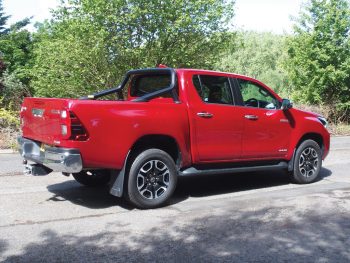Work or play, the Hilux Invincible is a solid off-road choice, reckons John Kendall.

Customers don’t have as much choice as they used to in the pickup market since the departure of Mitsubishi and Nissan. Even so that still leaves a choice of Ford, Isuzu, Ssangyong and, of course, Toyota. It was only last year when the latest version of the long-running Toyota Hilux went on sale, refreshing one of the company’s best-known products on the international stage.
Gone are the days when Toyota only offered relatively modest power output. Customers have a choice between a 2.4-litre, 148hp, four-cylinder turbo-diesel, or 2.8-litre, 201hp four-cylinder turbo-diesel. This engine was introduced with the new model. Opt for the 2.8-litre engine and there’s a choice of either six-speed manual or six-speed automatic transmission. Our test vehicle came with the 2.8-litre engine and automatic transmission. All models are equipped with four-wheel-drive as standard and there is a choice of driver-selectable Eco and power mode settings.
There is also a full-range of body styles from a single-cab model to the Extra cab, an extended single cab, providing folding seats behind the front seats for occasional use, or alternatively, additional storage space. The double cab, tested here, provides a compromise between seating for four to five adults, with a reduced load box, although one that will still provide a 1,000kg payload. Regardless of which model you choose, they all offer a maximum 3,500kg towing capacity.
Hilux was treated to a new frontal design and a refreshed interior. Standard equipment includes air conditioning, automatic headlights, Radio and CD player with Bluetooth connectivity and USB port. Toyota Safety Sense is also standard equipment which includes a Pre-Collision System, adaptive cruise control, lane departure alert and Road Sign Assist.
Invincible models, like our test vehicle, get front and rear parking sensors, LED rear lights, 18-inch alloys, heated front seats, auto-dimming rear-view mirror and windscreen wiper de-icer. There are also LED headlights, smart entry and push-button start as well as a tailgate damper and automatic air conditioning.
As we’ve said, the load area is something of a compromise with the double cab, while Toyota’s accessories list is a long one with a choice of hard tops and roller shutter covers for the load area.
On the road, the Hilux offers a traditional pickup ride with a tendency to roll, but the long-travel suspension that is partly the cause of that is necessary for a load bearing, off-road vehicle. Axle articulation is needed to ensure the Hilux will keep going over rough terrain and that inevitably means long travel suspension.
The engine can certainly deliver the power. It may not be the most refined diesel available but with 500Nm of torque available it should have no difficulty towing or making progress across rough terrain, which is what the Hilux was designed for. It’s a capable motorway cruiser too and can cruise all day at speeds above the legal limit. Fuel consumption reflects the power and torque available and it is unlikely to be an issue for pickup users who will choose the Hilux because they need its capabilities. If you are in the market for a 4×4 pickup, the Hilux’s reputation goes before it.
IN BRIEF
WHAT IS IT? Double cab pickup
HOW MUCH? £35,045 OTR
GROSS PAYLOAD? 1,010kg
ECONOMY? 28.5 – 30.0mpg (WLTP)
DRIVE? 201hp at 3,000rpm-3,400rpm /500Nm torque @ 1,600rpm-2,800rpm, 2.8-litre turbo-diesel
VERDICT
The Hilux reflects Toyota’s years of experience in producing 4×4 off-road vehicles. Choosing one is not likely to be something that fleet operators will regret.

